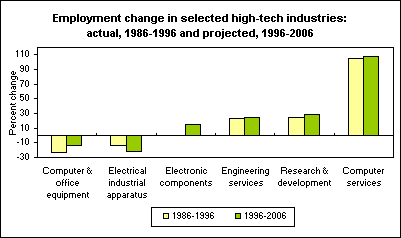An official website of the United States government
 United States Department of Labor
United States Department of Labor
Employment in high-tech industries grew more slowly between 1986 and 1996 than employment in the total nonfarm economy. A new study from BLS shows that employment in high-tech industries rose by only 9 percent in this period, while overall employment was up by 20 percent.

[Chart data—TXT]
However, employment in high-tech industries is projected to increase by 23 percent in 1996-2006, compared to a projected growth rate of 15 percent for total employment. Also, the gains in employment have not been equally distributed among high-tech industries. In some industries, such as computer and office equipment manufacturing, employment dropped from 1986 to 1996 and is projected to fall in the subsequent 10-year period. Other industries, most notably computer and data processing services, experienced tremendous employment growth in 1986-1996 and this growth is expected to continue.
Projections data are from the BLS Employment Projections program. Find more information on high-tech employment and wages in "High-technology employment: a broader view," by Daniel Hecker, Monthly Labor Review, June 1999. This study identifies 29 specific industries as high-tech.
Bureau of Labor Statistics, U.S. Department of Labor, The Economics Daily, High tech doesn’t always mean high growth at https://www.bls.gov/opub/ted/1999/jul/wk4/art04.htm (visited November 15, 2025).

